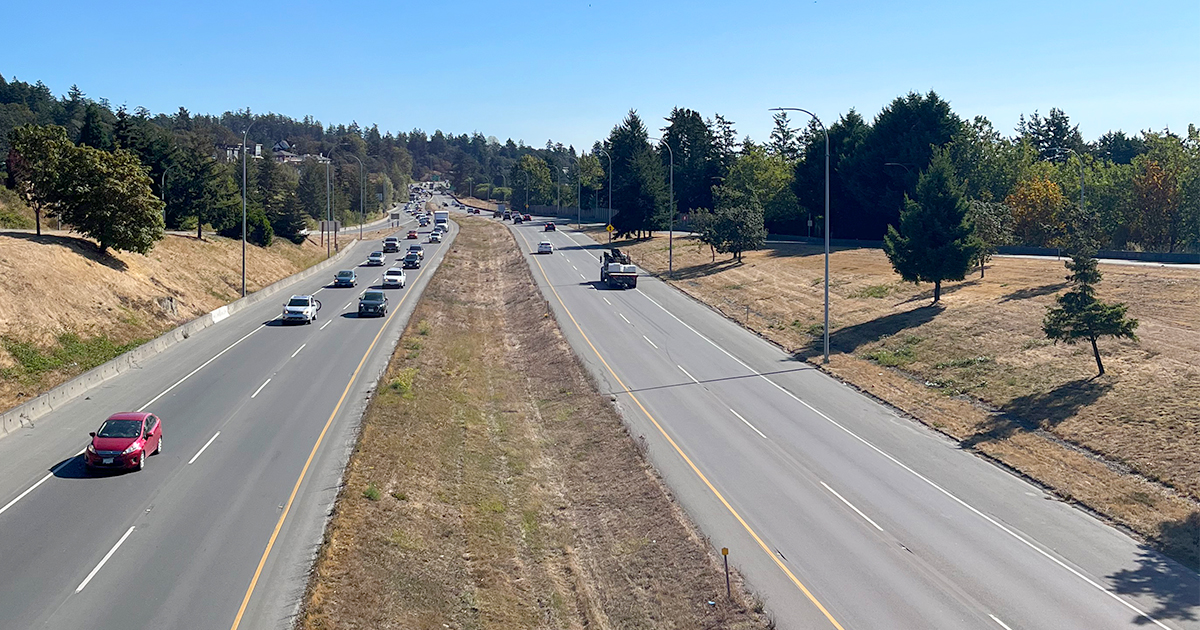Highway 1 Bus on Shoulder McKenzie to Colwood

This project will create new bus-on-shoulder facilities between the McKenzie interchange and the Colwood (terminating at the Island Highway intersection) to make transit an easier, faster and more desirable option for people commuting in southern Vancouver Island.
Project map
Traffic impacts
Ongoing
- Expect minor stoppages on Highway 1 eastbound (inbound) to Helmcken Road off-ramp
During construction some traffic impacts and delays can be expected.
- Traffic flow will be maintained during construction
- Local access to businesses in the area will not be affected by construction
- Accessible pedestrian access to bus stops will be maintained at all times
- Expect temporary lane closures during non-peak travel hours but not during the morning and afternoon commute times
- Expect limited Galloping Goose Trail closures during non-peak hours for the new Galloping Goose Trail pedestrian bridge, detours will be in place as required
For up-to-date information, visit www.DriveBC.ca
BCTransit impacts
This will remain an active transit corridor during construction. Riders can check BC Transit alerts for changes to routes.
Status
Construction is anticipated to start March 20, 2025 with tree clearing. Major works are anticipated to start in April 2025.
Further updates will be provided as the work progresses.
Project overview
Improving this section of road will ensure a continuous and functional rapid bus system.
This project aligns with the South Island Transportation Strategy’s goal to construct more bus lanes along highways and other inter-regional service corridors and to develop the Rapid Transit Corridor along Highway 1.
This work connects to improvements currently being made to the Colquitz Bridges Widening project and transit improvement work that BC Transit is completing from the Six Mile area to View Royal. It will create a more reliable transit service for all users on this route from downtown Victoria to the Juan de Fuca Bus Exchange. The section between McKenzie and Colwood is prone to traffic congestion. Dedicated bus lanes will ease congestion along this busy route and keep riders moving, especially in peak travel hours – saving commuters time, fuel and money while improving reliability.
This project will include:
- Converting and widening 3.7 km between the McKenzie and Colwood Interchanges on Highway 1
- 3.7 km of new dedicated outbound (westbound) bus-on-shoulder facilities
- 3.1 km of new dedicated inbound (eastbound) bus-on-shoulder facilities
- Widening ramps to provide priority access to bus stops at interchanges
- Installing roadside barriers, additional signage and warning flashers
- Constructing a new bridge on the Galloping Goose Trail for pedestrians and cyclists crossing Craigflower Creek
- New rapid bus stops at the Helmcken Interchange eastbound and westbound intersections
Project cost
Total project funding is $95 million, with the Government of British Columbia contributing $67 million in funding and the Government of Canada contributing $28 million in funding.
Schedule
Construction works beginning by March 20, 2025 and will continue until late fall 2027.
Project objectives
The project will provide two completely dedicated bus on shoulder facilities from the McKenzie Interchange to the Colwood interchange.
With an exclusive facility on the shoulder of Highway 1, busses are removed from the general-purpose traffic stream and congestion, and riders are more assured to arrive at their destinations at scheduled arrival and departure times.
As traffic and congestion grows on Highway 1, rapid transit will continue to be able to travel on the shoulder bus facilities to avoid congestion and strengthen connections between communities.
Bus stops and stations are being designed to accommodate accessibility and active transportation needs for all travelers.
Benefits
This project will:
- Provide BCTransit commuters with an easier trip between work and home
- Make transit an easier, faster and more desirable option for people
- Ensure a continuous, reliable and functional rapid bus experience
Environmental benefits
Reducing travel time and increasing ridership is expected to save over 400 tonnes of CO2 emissions per year. That would be equivalent to taking over 100 single-occupancy vehicles off the road annually.
This reduction amount will increase dramatically as BC Transit electrifies the Victoria Regional Transit fleet. Additionally, restoration of a Beaver Pond downstream of the Galloping Goose trail pedestrian bridge will provide offsetting measures for the bridge’s impact on riparian vegetation.
Dedicated bus on shoulder facilities
RapidBus is designed to deliver consistent and frequent bus service, limiting stops to high passenger volume areas. This project will accelerate RapidBus implementation, making transit for the South Island faster and more reliable. These lanes will:
- Allow the RapidBus service to use the shoulders along designated areas of the highway to travel
- Support all buses that travel along the route
- Prioritize buses over single-occupant vehicles
Save time
Dedicated facilities can reduce delays for buses considerably, resulting in reduced travel times and increased reliability. Dedicated bus facilities will
- Allow buses to bypass congestion between West Shore and downtown – especially in areas prone to congestion during peak travel hours
- Make taking the bus an even easier choice, so people can count on getting to their homes and work as quickly as possible
- Help improve travel times up to approximately 20 per cent over current travel times, saving up to five minutes
- This is in addition to the 20-minute savings the existing bus lanes between downtown Victoria and Tillicum Road along Highway 1 have already provided
- With new improvements underway, including the Colquitz Bridge Widening improvement work and Highway 1 Bus On Shoulder Lanes, time savings are expected to increase significantly
Accessibility
- All conventional buses in the Victoria region have bike racks that can hold up to two bikes and they all have the necessary accessibility equipment to accommodate passengers with mobility issues
- Handydart will have access to these transit-priority lanes
News Releases
Contact information
Friendly Url for this page:
gov.bc.ca/hwy1busonshoulder
Contact us about this project:
Subscribe
Enter your email address to subscribe to updates of this page.
